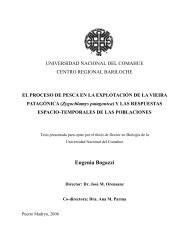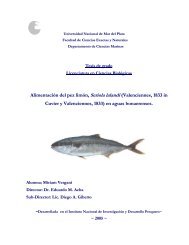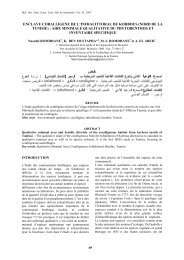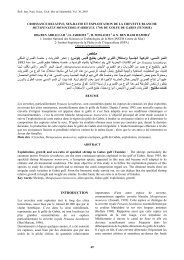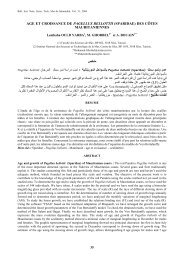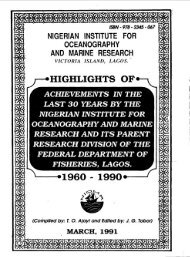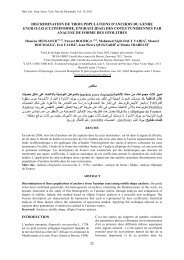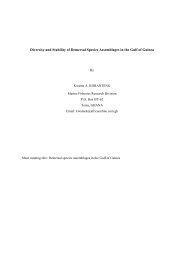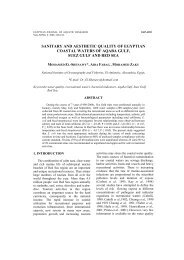Coastal vulnerability, resilience and adaptation to ... - OceanDocs
Coastal vulnerability, resilience and adaptation to ... - OceanDocs
Coastal vulnerability, resilience and adaptation to ... - OceanDocs
Create successful ePaper yourself
Turn your PDF publications into a flip-book with our unique Google optimized e-Paper software.
policy plan or decision. Instead, au<strong>to</strong>nomous <strong>adaptation</strong> will be triggered by market or welfare<br />
changes induced by climate change. Au<strong>to</strong>nomous <strong>adaptation</strong> in human systems would<br />
therefore be in the ac<strong>to</strong>r’s rational self-interest, whilst the focus of planned <strong>adaptation</strong> is on<br />
collective needs (Leary, 1999). Thus defined, au<strong>to</strong>nomous <strong>and</strong> planned <strong>adaptation</strong> largely correspond<br />
with private <strong>and</strong> public <strong>adaptation</strong>, respectively (see Figure 2).<br />
Anticipa<strong>to</strong>ry<br />
Reactive<br />
Natural<br />
Systems<br />
· Changes in length of growing season<br />
· Changes in ecosystem composition<br />
·Wetl<strong>and</strong> migration<br />
Human<br />
Systems<br />
Private<br />
Public<br />
· Purchase of insurance<br />
· Construction of houses on stilts<br />
·Redesign of oil-rigs<br />
· Early-warning systems<br />
· New building codes, design st<strong>and</strong>ards<br />
· Incentives for relocation<br />
·Changes in farm practices<br />
· Changes in insurance premiums<br />
· Purchase of air-conditioning<br />
·Compensa<strong>to</strong>ry payments, subsidies<br />
· Enforcement of building codes<br />
· Beach nourishment<br />
Figure 2 — Matrix showing the five prevalent types of <strong>adaptation</strong> <strong>to</strong> climate change, including<br />
examples (based on Klein, 1998).<br />
Article 3.3 of the UNFCCC suggests that anticipa<strong>to</strong>ry planned <strong>adaptation</strong> (as well as<br />
mitigation) deserves particular attention from the international climate change community:<br />
“The Parties should take precautionary measures <strong>to</strong> anticipate, prevent or minimise the causes of climate<br />
change <strong>and</strong> mitigate its adverse effects. Where there are threats of serious or irreversible damage, lack<br />
of full scientific certainty should not be used as a reason for postponing such measures, taking in<strong>to</strong> account<br />
that policies <strong>and</strong> measures <strong>to</strong> deal with climate change should be cost-effective so as <strong>to</strong> ensure<br />
global benefits at the lowest possible cost. (...).”<br />
Anticipa<strong>to</strong>ry <strong>adaptation</strong> is aimed at reducing a system’s <strong>vulnerability</strong> by either minimising<br />
risk or maximising adaptive capacity. Five generic objectives of anticipa<strong>to</strong>ry <strong>adaptation</strong><br />
can be identified (Klein <strong>and</strong> Tol, 1997; Klein, 2001):<br />
Increasing robustness of infrastructural designs <strong>and</strong> long-term investments—for example<br />
by extending the range of temperature or precipitation a system can withst<strong>and</strong> without<br />
failure <strong>and</strong>/or changing a system’s <strong>to</strong>lerance of loss or failure (e.g., by increasing economic<br />
reserves or insurance);<br />
Increasing flexibility of vulnerable managed systems—for example by allowing mid-term<br />
adjustments (including change of activities or location) <strong>and</strong>/or reducing economic lifetimes<br />
(including increasing depreciation);<br />
Enhancing adaptability of vulnerable natural systems—for example by reducing other<br />
(non-climatic) stresses <strong>and</strong>/or removing barriers <strong>to</strong> migration (such as establishing ecocorridors);<br />
Reversing trends that increase <strong>vulnerability</strong> (“mal<strong>adaptation</strong>”)—for example by introducing<br />
zoning regulation in vulnerable areas such as floodplains <strong>and</strong> coastal zones;<br />
Improving societal awareness <strong>and</strong> preparedness—for example by informing the public of<br />
the risks <strong>and</strong> possible consequences of climate change <strong>and</strong>/or setting up early-warning<br />
systems.<br />
Each of these five objectives of <strong>adaptation</strong> is relevant for coastal zones. However, for<br />
coastal zones another classification of <strong>adaptation</strong> options is often used. This classification, introduced<br />
by IPCC CZMS (1990) <strong>and</strong> still the basis of many coastal <strong>adaptation</strong> analyses, distinguishes<br />
between the following three basic strategies:<br />
19






